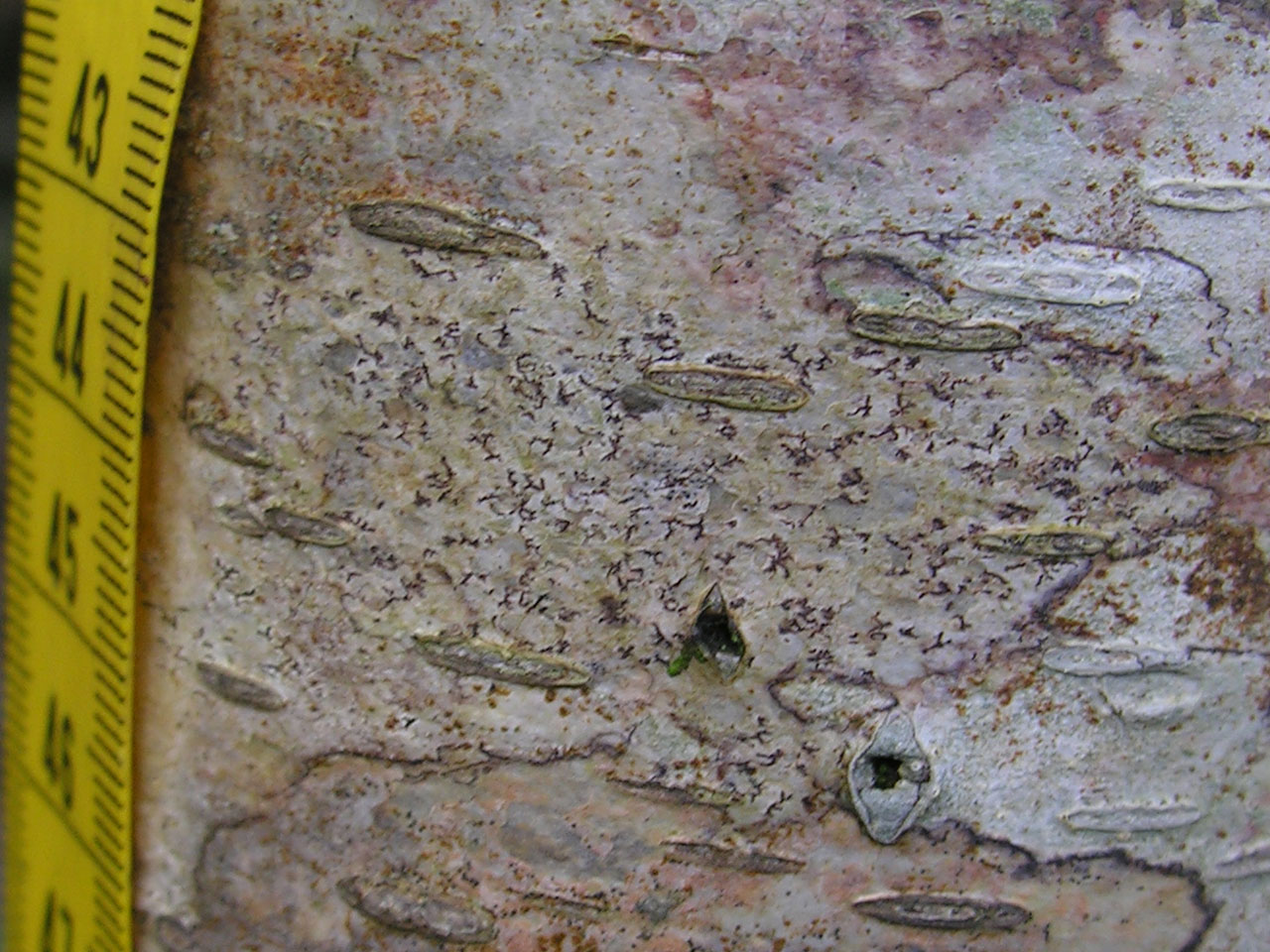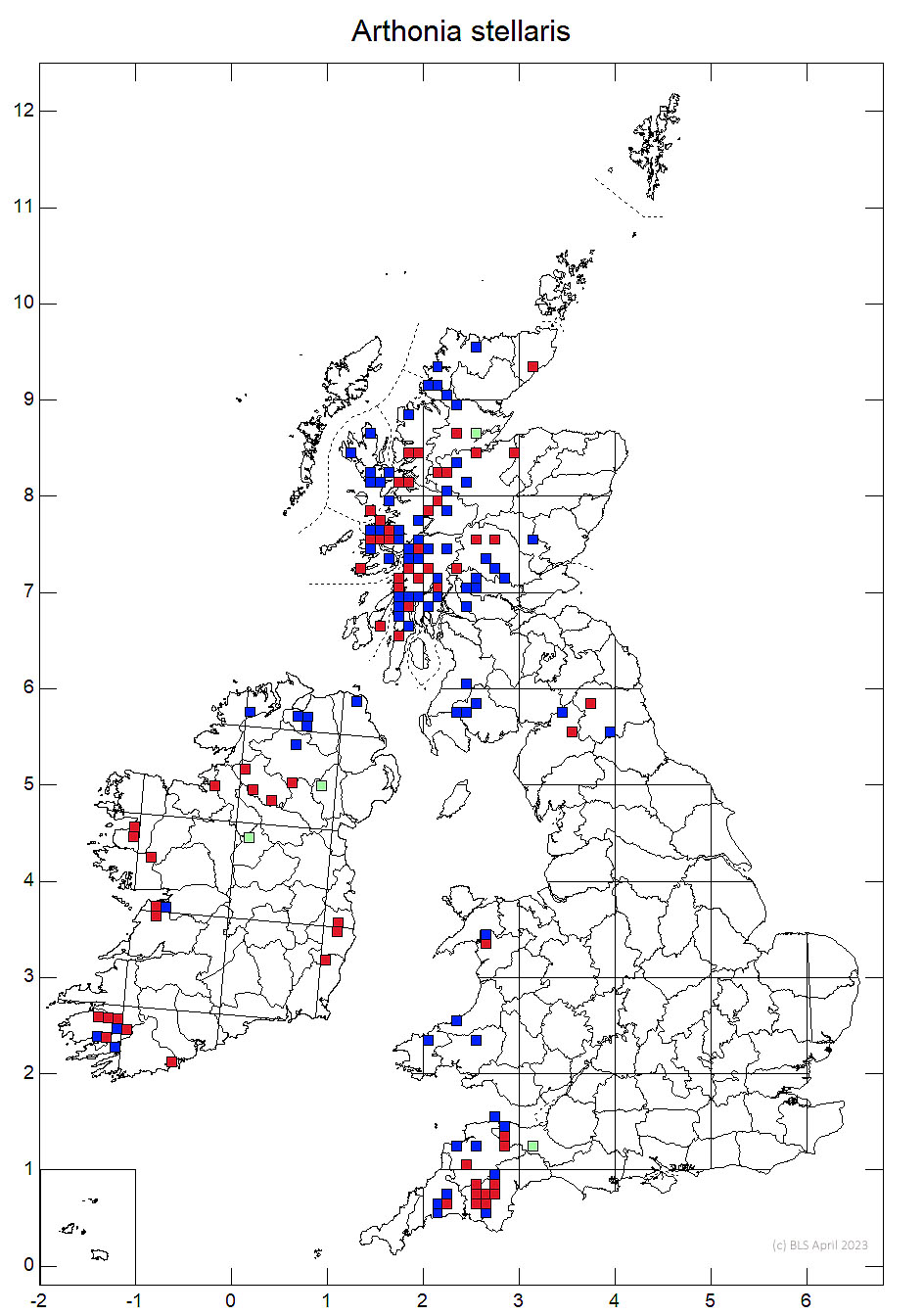Arthonia stellaris
A small Arthonia s. lat. of smooth bark on old or slow growing trees and bushes characteristic of upland pasture woodlands which is locally frequent in Scotland, scarce elsewhere. Can be spotted in the field by its very narrow but long sinuous sparingly branched black apothecia without pruina, but checking under the microscope is recommended.
Thallus immersed, often delimited by a brown line and usually 1–2 cm diam., sometimes larger on tree trunks, white with a green or grey tinge, or pale fawn. Apothecia linear or more usually irregularly branched to stellate and to 2 mm diam., with ‘arms’ 0.08–0.15 mm wide, red-brown to brown-black, not pruinose but sometimes covered by a thin layer of bark cells; in section 60–95 μm tall; epithecium red-brown, K+ pale green; hymenium 40–50 μm tall, colourless or pale red-brown above; hypothecium indistinct or to 20 μm tall, colourless or pale red-brown, K+ pale green in patches; paraphysoids 1 (–1.5) μm diam., brown-walled and to ca 2 μm wide in the epithecium, sometimes with dark apical caps. Ascospores (13–) 16–22 (–24) × (5–) 6–7 (–9) μm, obovoid to cylindric-obovoid, (2–) 3- or 4-septate; apical cells enlarged; old ascospores brown and warted. Pycnidia rare, immersed, 40–60 μm diam., the wall red-brown, K+ pale green; conidia 4.5–5.5 × 0.5–1 μm. Thallus C–, K–, KC–, Pd–, UV– (unidentified substance in TLC).
In the field there is the potential to overlook the species as a narrow branched variant of Arthonia radiata, but this has apothecia that are not as elegant and the spores lack enlarged apical cells. Can be confused with other species with ascospores with enlarged apical cells such as Arthonia anglica (C+ red apothecia), Reichlingia anombrophila (smaller spores), A. ilicinella (apothecia irregularly rounded & old spores with a smooth wall), R. zwackhii (partly lichenicolous and apothecia with UV– white pruina), Synarthonia astroidestera (apothecia with UV+ orange white pruina) with or weakly pigmented morphs of Coniocarpon cuspidans (K+ crimson apothecia), and the lichenicolous A. invadens (normally visibly lichenicolous and more stellate apothecia).
On smooth bark, especially of Hazel, Holly, Oak and Rowan, in old woodland.

Widespread in W. Britain and Ireland, locally frequent in Scotland, scarce elsewhere. [Records from lowland southern England are likely errors]
A characteristic species of lichen rich old woodland in upland Britain and Ireland. Needs sheltered and well lit situations and likely to be adversly impacted by the removal of grazing from upland pasture woodlands due to increases in shade.
Britain: Notable
Cannon, P., Ertz, D., Frisch, A., Aptroot, A., Chambers, S., Coppins, B. J., Sanderson, N. A., Simkin, J. & Wolseley, P. (2020) Arthoniales: Arthoniaceae, including the genera Arthonia, Arthothelium, Briancoppinsia,Bryostigma, Coniocarpon, Diarthonis, Inoderma, Naevia, Pachnolepia, Reichlingia, Snippocia, Sporodophoron, Synarthonia and Tylophoron. Revisions of British and Irish Lichens 1: 1 - 48
Text by Neil Sanderson based on Cannon et al (2020)

